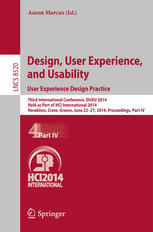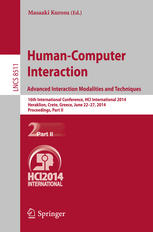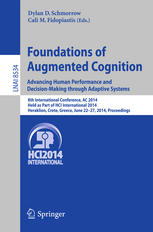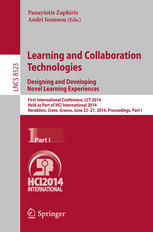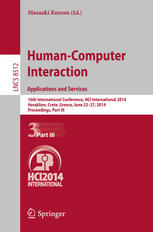Digital Human Modeling Applications in Health Safety Ergonomics and Risk Management 5th International Conference DHM 2014 Held as Part of HCI International 2014 Heraklion Crete Greece June 22 27 2014 Proceedings 1st Edition by Vincent Duffy 3319077253 9783319077253
$50.00 Original price was: $50.00.$25.00Current price is: $25.00.
Digital Human Modeling Applications in Health Safety Ergonomics and Risk Management 5th International Conference DHM 2014 Held as Part of HCI International 2014 Heraklion Crete Greece June 22 27 2014 Proceedings 1st Edition by Vincent G. Duffy – Ebook PDF Instant Download/DeliveryISBN: 3319077253, 9783319077253
Full download Digital Human Modeling Applications in Health Safety Ergonomics and Risk Management 5th International Conference DHM 2014 Held as Part of HCI International 2014 Heraklion Crete Greece June 22 27 2014 Proceedings 1st Edition after payment.
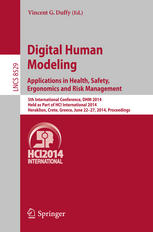
Product details:
ISBN-10 : 3319077253
ISBN-13 : 9783319077253
Author: Vincent G. Duffy
This book constitutes the refereed proceedings of the 5th International Conference on Digital Human Modeling and Applications in Health, Safety, Ergonomics and Risk Management 2014, held as part of the 16th International Conference on Human-Computer Interaction, HCII 2014, held in Heraklion, Crete, Greece in June 2014, jointly with 13 other thematically conferences. The total of 1476 papers and 220 posters presented at the HCII 2014 conferences were carefully reviewed and selected from 4766 submissions. These papers address the latest research and development efforts and highlight the human aspects of design and use of computing systems. The papers accepted for presentation thoroughly cover the entire field of Human-Computer Interaction, addressing major advances in knowledge and effective use of computers in a variety of application areas. The 65 papers included in this volume are organized in topical sections on modeling posture and motion; anthropometry, design and ergonomics; ergonomics and human modeling in work and everyday life environments; advances in healthcare; rehabilitation applications; risk, safety and emergency.
Digital Human Modeling Applications in Health Safety Ergonomics and Risk Management 5th International Conference DHM 2014 Held as Part of HCI International 2014 Heraklion Crete Greece June 22 27 2014 Proceedings 1st Table of contents:
Human Energy Expenditure Models: Beyond State-of-the-Art Commercialized Embedded Algorithms
1 Introduction
2 Method
2.1 Database and Protocol
2.2 Activity Classification and Human Speed Estimation
2.3 Human Energy Expenditure Models
3 Results
3.1 Performance of the Three Proposed Models
3.2 Commercial off-the-Shelf EE Monitoring Devices
4 Discussion
4.1 Performance and Validation
4.2 Models versus Commercialized Devices
References
Human Skeleton Extraction of Depth Images Using the Polygon Evolution
1 Introduction
2 The Proposed Approach
2.1 External Polygon Generation
2.2 Internal Polygon Generation
2.3 Skeleton Extraction
2.4 Skeleton Linking
3 Experiments and Comparison
4 Conclusions
References
Biomechanics Investigation of Skillful Technician in Spray-up Fabrication Method
1 Introduction
2 Methodology
2.1 Subjects
2.2 Measurement Techniques
2.3 Analysis Objective
2.4 Spray up Method
2.5 Three-Dimensional Motion Measurement
2.6 Eye Movement Measurement
2.7 Dimensional Stability
3 Results and Considerations
3.1 Process Analysis
3.2 Motion Analysis
3.3 Eye Movement Analysis
3.4 Dimensional Stability
4 Conclusions
References
Study on Three Dimensions Body Reconstruction and Measurement by Using Kinect
1 Introduction
2 Kinect
3 Point Cloud
4 Depth Image Processing by Kinect
5 Point Cloud Data Processing
6 Conclusion
References
Comparison of Gait Analysis by the Way of Semi-structured Interviews
1 Introduction
2 Method
2.1 Subjects
2.2 Models for Walking Video
2.3 Collection of Data
2.4 Categorization
3 Results
3.1 Region
3.2 Time
3.3 Function
3.4 Correlation between Region and Time
3.5 Correlation between Region and Function
3.6 Correlation between Time and Function
4 Discussion
5 Conclusion
References
Motion Analysis of the Pounding Technique Used for the Second Lining in the Fabrication of Tradition
1 Introduction
2 Method
2.1 Subjects
2.2 Procedure Under Analysis
2.3 Measuring Conditions for Motion Analysis
2.4 Measuring Methods for Peel Test
2.5 Results and Discussion
3 Conclusion
References
Analysis of Expert Skills on Handheld Grinding Work for Metallographic Sample
1 Introduction
2 Experimental Method
2.1 Subjects
2.2 Samples to be Ground
2.3 Grinding Machine
2.4 Motion Analysis Method
2.5 Electromyographic Measurement System
2.6 Data Analysis
3 Results
3.1 Characteristics in Motions
3.2 The Muscle Activity Pattern
3.3 Muscle Activity Relative Value
3.4 The Average EMG during Grinding Motion
4 Discussions
5 Conclusions
References
Caregiver`s Gaze and Field of View Presumption Method During Bath Care in the Elderly Facility
1 Research Background and Problem Identification
1.1 Nursing Care for the Elderly
1.2 Bathing Assistance: Its Background and Issues
1.3 Research Trends in Bathing Assistance
1.4 Identifying the Problem
2 Preventing Accidents during Bathing Assistance
2.1 Causes of Falls: Care Receivers’ Physical Issues
2.2 Causes of Falls: Environmental Factors
2.3 Predicting and Safeguarding against Falls
2.4 Solving Problems
3 Predicting Positions and Field of Vision
3.1 Motion Capture
3.2 Estimating by Using Motion Sensors
4 Suggested Systems
4.1 System Outline
4.2 Basic Experiment
5 Conclusion
References
Anthropometry, Designand Ergonomics
Research on the Continuous Descent Approach (CDA) Operational Error of Pilot Base on Cloud Model and
1 Introduction
2 Research Model
2.1 The Cloud Model
2.2 The Normal Cloud Model
2.3 Backward Cloud Generator Procedure Code
2.4 The Cloud Model of RTA Error
2.5 The Risk Layer of RTA Error
3 Research on Operational Error of Pilot
3.1 Operational Error of Pilot
3.2 Research Prospect of Uncertainty Theory
4 Conclusion
References
Study on the Evaluation of Automotive Seat Comfort during Prolonged Simulated Driving
1 Introduction
2 Method
3 Results and Dopiscussion
3.1 Subjective Survey
3.2 Electromyography
3.3 Pressure Distribution
3.4 Oxygen Saturation
4 Conclusion
References
Simulation on Thermal Control System of the Extravehicular Spacesuit
1 Introduction
2 The Composition of the Spacesuit Thermal Control System and Thermal Model
2.1 Thermal Equation of State of the Outer Protective Layer
2.2 Heat Balance Equation of the Ventilation Layer Gas
2.3 Liquid Thermal Power Equation of the Liquid Circuit
3 Parameters Affecting the Life Support System
3.1 Water Sublimator
3.2 Temperature Adjustment Device
4 Dynamics Model of the Thermal Control System
4.1 Model of Warm Body Mummy
4.2 Heat Control System Parameters
5 Result and Analysis of System Feature and Simulation
5.1 Low Temperature Simulation
5.2 Average Out Heat Flow Heat Simulation
6 Conclusion
References
Calibration of Online Situation Awareness Assessment Systems Using Virtual Reality
1 Introduction
2 Background
2.1 Situation Awareness
2.2 SA-Based adaptive interfaces
2.3 Computational Models of SA Lack Validation
3 Evaluation and Calibration of Online SA Assessment Systems
3.1 Requirements
3.2 Process Indices
3.3 SA and Virtual Reality
4 Virtual Reality Experiment
4.1 The Virtual Reality Flight Simulator
4.2 Methodology
4.3 Example of Calibration
5 Conclusion
References
A Digital Human Model for Performance-Based Design
1 Introduction
2 Background
3 Method
3.1 Multi-dimensional Zone Differentiation
3.2 Computational Speed
3.3 Sphere Filling
3.4 Zone Differentiation Compute Instance (ZDCI)
3.5 Iso-contour Surfacing
4 Results
5 Discussion
References
Context-Aware Posture Analysis in a Workstation-Oriented Office Environment
1 Introduction
2 Related Works
3 System Architecture
4 Skeleton Tracking
5 Workstation Environment Tracking
6 Model-Matching
7 Experimental Results
7.1 Experimental Setup
7.2 Results
7.3 Discussion
8 Conclusion and Future Work
References
Comfort Evaluation of Cockpit Based on Dynamic Pilot Posture
1 Introduction
2 Comfortable Evaluation Method of Cockpit Based on Dynamic Pilot Posture
3 Dynamic Manipulation Data Capture
4 Comfort Evaluation of Dynamic Pilot Data
5 Validation of the Method
6 Conclusion
References
Based on Upper Extremity Comfort ROM of Ergonomic Methods for Household Products Design
1 Introduction
2 Methods
2.1 Participants
2.2 Different Heights and Distances Fetching Tasks
2.3 Fetching Tasks of Different Upper Limb Joint Angle
3 Results
3.1 Upper Limb Comfortable Motion Range
3.2 DHM Results
4 Discussion and Conclusion
References
Measurement and Analysis of Anthropometric Parameters of Young Male Vehicle Drivers
1 Introduction
2 Method
2.1 Anthropometric Parameters
2.2 Anthropometric Method
2.3 Participant
2.4 Data Processing
3 Results and Analysis
3.1 Correlation Analysis
3.2 Fitting Analysis
3.3 Contrast with GJB1835-1993
4 Discussion
5 Conclusion
References
Ergonomics and Human Modelling in Work and Everyday Life Environments
Future Applied Conventional Technology Engineering New Academic Fields from Manufacturing Country JA
1 Introduction
2 Case Study
2.1 Case Study 1: Motion Analysis of Body Movement between the Expert and the Non-expert Clay Plaste
2.2 Case Study 2: Effects of Motor Learning on the Edge Shape of Japanese Kitchen Knives
2.3 Case Study 3: Biomechanical Analysis of “Kyo-Gashi” Techniques and Skills for Japanese Sweet
3 Conclusions
References
Comparison of Different Tea Whisk Influence on Bubble Form in Processes of “The Way of Tea”
1 Introduction
2 Experiment
2.1 Participants
2.2 Subjects
2.3 Experimental Process
2.4 Image Processing
3 Results and Discussions
4 Conclusions
References
Bedroom Temperature and Sleeping Quality
1 Introduciton
2 Methods
3 Results
4 Conculsion
References
Comparison of Characteristics Recognition in the “Mitate” of Urushi Crafts
1 Introduction
2 Measurements
2.1 Subjects
2.2 Mitate Work for This Study
2.3 Measurement Condition
3 Results
3.1 Time of Mitate
3.2 Remark Points
3.3 Text-Mining
4 Discussion
5 Conclusion
References
Evaluation of Kyo-Yuzen-Zome Fabrics with Different Pastes
1 Introduction
2 Paste Application and the Function
2.1 Paste Application
2.2 Objective of Research
3 Materials
3.1 How to Manufacture Putting Paste
3.2 Viscosity
4 Experiment
4.1 Observation of Cutting Faces
4.2 Observation of Woven Surfaces
5 Results
5.1 Observation of Cutting Faces
5.2 Observation of Woven Surfaces
6 Discussion
6.1 Cutting Face and Surface
6.2 Dyeing Model
7 Conclusion
References
A Task Analytic Process to Define Future Concepts in Aviation
1 Introduction
1.1 Current Day Operations
1.2 Single Pilot Operations (SPOs)
1.3 Research Objectives
1.4 Method
1.5 Task Representation
1.6 Concept Verification Process and the Impact of SPO on Operator Roles and Responsibilities
1.7 Candidate Roles and Responsibilities Considerations
1.8 Future Research
References
Application of E-learning System Reality in Kyoto-style Earthen Wall Training
1 Introduction
2 The Present Situation and the Development of Kyoto-style Earthen Wall Training
2.1 The Problems in the Kyoto-style Earthen Wall Training Industry
2.2 Quantifiable Research on the Kyoto-style Earthen Technique
2.3 The Development Direction of the Kyoto-style Earthen Wall Training
3 The Realization of E-learning System in Kyoto-style Earthen Wall Training
3.1 The Establishment of E-learning System
3.2 The Usage Method of E-learning System
3.3 The Characteristic of E-learning System
4 Conclusions
References
The Influence of Shift Workers Sleeping Quality upon Job Performance
1 Introduction
1.1 Sleep Quality
1.2 Sleep Quality of Shift Workers
1.3 The Impact of Sleep Quality on Work Efficiency
1.4 Assessment Method of Sleep Quality
2 Result and Suggestion
References
The Classification Tendency and Common Denomination of the Points Paid Attention in Ikebana Instruct
1 Introduction
2 Method
2.1 Outline
2.2 Teachers
2.3 Arrangers and Place Taken
2.4 Format and Materials Used
2.5 Collecting Date
2.6 Categories of Comments and Structuring the Categories
3 Result
4 Considerations
5 Conclusion
References
Analysis and Comparison of Ergonomics in Laparoscopic and Open Surgery – A Pilot Study
1 Objective
2 Significance
3 Methods
4 Results
4.1 Perceived Demands and Physical Complaints
4.2 Muscular Strain (sEMG)
4.3 Life Record Data
5 Discussion and Conclusion
References
Effect of Wall Material of a Room on Performance in Long Monotonous Work
1 Introduction
2 Method
2.1 Subject
2.2 Measurement Environment
2.3 Measurement Method
2.4 Video Recording
2.5 EEG Measurement
2.6 Fatigue Survey
2.7 Survey of Work Error
3 Results
3.1 EEG Measurement for Fatigue Survey
3.2 Work Time, Total Number of Sorted Papers, Number of Ripped Papers and Torn Papers
3.3 Correlation between Work Time and Error
3.4 Correlation between Work Efficiency and Error Per One Piece of Paper
4 Conclusion
References
Comparative Study on the Feature of Kitchen Knife Sharpening Skill between Expert and Non-Expert
1 Introduction
2 Experiments
2.1 Participants
2.2 Subject
2.3 Measurement Setting
2.4 Processing Investigation
2.5 Observation of the Knife Edge
3 Results and Discussions
3.1 Process Analysis Results
3.2 Knife Blade Edge Observation
4 Conclusions
References
Visual Behavior in a Japanese Drum Performance of Gion Festival Music
1 Introduction
2 Methods
2.1 Participants
2.2 Experiment
2.3 Acquisition and Processing of Gaze Data
3 Results
3.1 Number of Gaze Shifts
3.2 Percentage of Gaze Location
3.3 Time-Series of Gaze Location
4 Discussion
5 Conclusion
References
Advances in Healthcare
Understanding and Facilitating the Communication Process among Healthcare Professionals
1 Introduction
2 Related Works
3 Contextualization
3.1 Infrastructure of Clemente Ferreira Hospital
3.2 Developing Collab: Participatory Design Sections
4 Collab System
4.1 Collab Experiment and Data Analysis
5 Conclusion
References
PEGASO: Towards a Life Companion
1 Introduction
2 The PEGASO ICT System
3 Affective Design
4 Companion Tailoring
5 Towards a Life Companion
6 Conclusion
References
Biomechanical Study of Foot Force Pattern in Hallux Valgus (HV) Patients
1 Introduction
2 Methodology
2.1 Subjects
2.2 Data Collection
3 Data Analyses
3.1 Foot Scan
3.2 Motion Capture
4 Conclusion
References
An Environment for Domestic Supervised Amblyopia Treatment
1 Using 3D for Amblyopia Treatment and Diagnosis
2 Use Cases for a Distributed Environment
3 Distributed Architecture
4 Conclusions
References
Active Prevention by Motivating and Engaging Teenagers in Adopting Healthier Lifestyles:
1 Introduction
2 Methodological Approach
2.1 Identifying the Users and Their Needs
2.2 UCD Methodology in PEGASO
3 Preliminary Results and Discussion
3.1 The PEGASO Features
3.2 The PEGASO Architecture
4 Conclusions
References
Robot Patient for Nursing Self-training in Transferring Patient from Bed to Wheel Chair
1 Introduction
2 Design Specification
2.1 Procedures of Transferring a Patient from Bed to Wheelchair
2.2 Design Specification of the Robot Patient
3 Hardware Configuration
3.1 Joint Configuration of the Robot Patient
3.2 Arms
3.3 Knee Joints
4 Control Methods
4.1 Voice Interaction
4.2 Physical Interaction of Body Limbs
5 Experiment
5.1 Procedures
5.2 Results and Discussion
6 Conclusion
References
Evaluating the Healthcare Management System by Usability Testing
1 Introduction
2 Literature Review
2.1 User Experience
2.2 Usability Metrics
2.3 Summary
3 Methodology
3.1 Questionnaire
3.2 Participants
3.3 Design of Experiment
3.4 Experiment Equipment
4 Results
4.1 Heart Rate Variety
4.2 Questionnaire Results
5 Conclusion
References
Building a Telemedicine Framework to Improve the Interactions between Cancer Patients and Oncology T
1 Introduction
2 Methods
2.1 Patient Satisfaction Survey
2.2 Triage Nurse Survey
3 Results
4 Discussion
References
Usability Challenges and Barriers in EHR Training of Primary Care Resident Physicians
1 Introduction
2 Method
2.1 Setting
2.2 Electronic Health Record
3 Results
4 Discussion
4.1 EHR Usability Issues
4.2 Improving EHR Learnability through EHR Training of Residents
5 Conclusion
References
Robotics as a Tool in Fundamental Nursing Education
1 Introduction
2 Methods
2.1 Participants
2.2 Procedures
2.3 Robot Patient
3 Results and Consideration
4 Conclusion
References
Integrated Architecture for Next-Generation m-Health Services (Education, Monitoring and Prevention)
1 Introduction
2 Methodological Approach
3 System Architecture
4 System Integration
5 Conclusion and Discussion
References
The Semantics of Refinement Chart
1 Introduction
2 Related Work
3 Refinement Chart
3.1 Motivation
3.2 Overview
3.3 Semantics of Refinement Chart (RC)
4 Case Study : Cardiac Pacemaker
4.1 Informal Description of Cardiac Pacemaker
4.2 Bradycardia Operating Modes
4.3 Development of Cardiac Pacemaker Using Refinement Chart
5 Conclusion
References
Pegaso: A Serious Game to Prevent Obesity
1 Introduction
2 Serious Games: A New Pedagogical Approach
3 Learning by Reflection: An Example from the Mirror Project
4 Conclusions
References
Virtual Knee Arthroscopy Using Haptic Devices and Real Surgical Images
1 Introduction
2 Related Work
3 Modeling the Arthroscopic Camera in Hybrid Image-Based Virtual Environment
3.1 Automatic Generation of Panoramic Images
3.2 Modeling Arthroscopic Camera and Surgical Instruments
3.3 Visualization of the Surgical Area
3.4 Depth Estimation for Haptic Rendering
4 Conclusion
References
Using Ontologies and Semantic Web Technology on a Clinical Pedigree Information System
1 Introduction
2 Overview of System Architecture
3 Usage of Ontologies and Semantic Web Technology
3.1 Introduction to Ontologies and Semantic Web Technology
3.2 Representation of Semantic Data
3.3 Benefits of Using Ontologies and Semantic Web Technology
4 Prototype Integration with a Health Information System
5 Conclusions and Future Work
References
Formalizing the Glucose Homeostasis Mechanism
1 Introduction
1.1 Motivation
2 Related Work
3 The Glucose Homeostasis System
4 Proposed Idea
4.1 Diabetes or Abnormal Homeostasis System
4.2 Blood Sugar Concentration
5 Formalization of the GH System
5.1 The Context and Abstract Model
5.2 Model Validation and Analysis
6 Conclusion and Future Challenges
References
ENT Disease Diagnosis Using an Expert System
1 Introduction
2 Background
3 Virtual Doctor – ENT Disease diagnosis System
4 Virtual Doctor Design and Implementation
5 Evaluation and Validation
6 Discussion
7 Conclusion
References
Application of Bayesian Networks in Consumer Service Industry and Healthcare
1 Introduction
2 Methodology and Tool
3 Case Study One: Traffic Volume Analysis of the Road System of the State of Indiana
3.1 Hypothesis
3.2 Modeling and Analysis
3.3 Results
4 Case Study Two: Analysis of Mental Health Risk Factor among Veterans and Civilians
4.1 Hypothesis
4.2 Modeling and Analysis
4.3 Results
5 Discussions
References
Rehabilitation Applications
Design and Ergonomics of Monitoring System for Elderly
1 Introduction
2 The Monitoring System
3 Methodology
4 Results
5 Conclusion
References
A Low Cost Haptic Mouse for Prosthetic Socket Modeling
1 Introduction
2 State of the Art
3 Haptic Mouse Prototype
3.1 Physics-Based Model of the Residuum
4 Preliminary Testing
5 Conclusions
References
Evaluating Work Disability of Lower Limb Handicapped within a Human Modeling Framework
1 Introduction
2 Modeling Method
3 Motion and Posture Generation Method
3.1 Kinematics Skeletal Model
3.2 Joint Kinematics Optimization
3.3 Joint Dynamic Optimization
4 Example
5 Conclusion
References
Development of a Tendon-Driven Dexterous Hand for Fine Manipulation
1 Introduction
2 Design
3 Result
4 Conclusion
References
Mobile Navigation for Limited Mobility Users
1 Introduction
2 Research and Related Work
3 Design
4 Functionalities
4.1 Customization
4.2 The Marking of Barriers
4.3 Interactivity
4.4 Computation of Individual, Barrier- Free Routes
5 Implementation and Technology
5.1 HTML5
5.2 Open Street Map
5.3 GPS
5.4 Computation of Routes and Barrier Handling
6 Testing
7 Conclusions and Next Steps
References
Analysis of Luria Memory Tests for Development on Mobile Devices
1 Introduction
2 Related Work
3 Luria Tests in the Research of Memory Processes
4 Interfaces in Mobile Devices
5 Analysis of Luria Memory Tests for Mobile Devices
5.1 Words Learning
5.2 Mediate Memory
5.3 Pictogram
5.4 Reproduction of Stories
5.5 Direct-Fixation Footprints Test
5.6 Summary
6 Case Study: Older Adults
7 Conclusion
People also search for Digital Human Modeling Applications in Health Safety Ergonomics and Risk Management 5th International Conference DHM 2014 Held as Part of HCI International 2014 Heraklion Crete Greece June 22 27 2014 Proceedings 1st:
digital human modeling and applications
what is digital modeling
examples of digitals for modeling
digital human modeling
digital human modeling symposium
Tags: Digital Human, Modeling Applications, Health Safety, Ergonomics, Risk Management, Vincent Duffy
You may also like…
Computers - Computer Science
Computers - Computer Science
Computers - Computer Science




